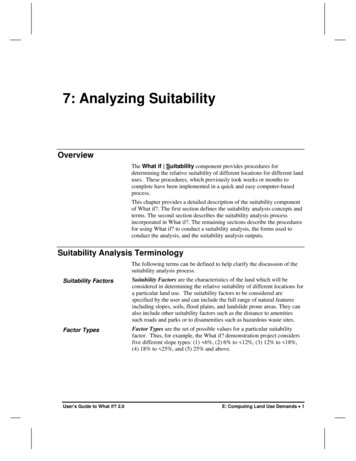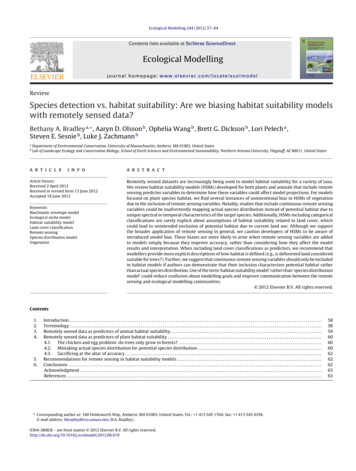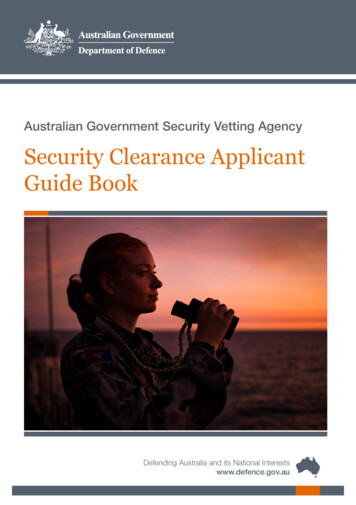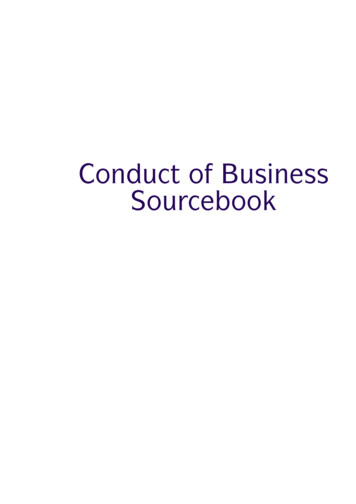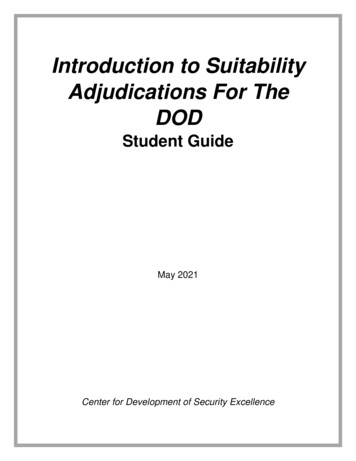
Transcription
Introduction to SuitabilityAdjudications For TheDODStudent GuideMay 2021Center for Development of Security Excellence
Introduction to Suitability Adjudications For The DODStudent GuideLesson 1: Course OverviewCourse IntroductionCourse OverviewImagine three individuals: Ernie, Tracey, and Lynn. Ernie has recently been laid off from hisjob in the private sector and is looking for civilian employment within the DOD. Years ago,Ernie was convicted of driving while intoxicated. He completed an alcohol treatmentprogram, but he continues to struggle with alcohol abuse. Tracey is an experienced billingsystems specialist applying for a position at a military installation. This position requires ahigh degree of public trust. Tracey has a history of theft in the workplace and wasterminated from her last job. Lynn is applying for an executive administrative assistantposition within the Defense Counterintelligence and Security Agency, or DCSA. Her resumelists a master’s degree from a prestigious university, but a background investigation revealsthat she never actually attended college.Which of these individuals is suitable for federal employment? How will you decide?The individuals in these examples are applying for civilian positions that require varyingdegrees of trust, but each of them also has character flaws and a history of conduct thatcould affect his or her ability to perform federal job duties with appropriate integrity,efficiency, and effectiveness. As a suitability adjudicator for the DOD, it is your job todetermine whether people like these are suitable for employment in the DOD.Welcome to the Introduction to Suitability Adjudications for the DOD course.Note: This course provides an introduction to DOD Suitability Adjudications. Per DODI1400.25, Volume 731, DOD Suitability Adjudicators are required to use the U.S. Office ofPersonnel Management, Federal Investigative Services Division "Suitability ProcessingHandbook", dated September 2008 when making all suitability determinations for coveredpositions. Designated DOD Suitability Adjudicators can obtain the OPM handbook from theirdesignated agency/component suitability point of contact (POC). The POC will release thehandbook after validating need and obtaining the appropriate signed receipt and agreementfrom the requesting adjudicator.Course ObjectivesThe overarching purpose of adjudications is to ensure that all individuals working in theDOD are loyal, trustworthy, and of good conduct. In this course you will learn aboutsuitability adjudications in the DOD and the role that suitability plays in protecting theintegrity of the federal civil service. You will learn the basic phases of suitability and theresponsibilities of OPM and the employing agency or component during each of thesephases. Finally, you will learn the specific role the DOD adjudicator plays in conductingsuitability adjudications.May 2021Center for Development of Security ExcellencePage 1-1
Introduction to Suitability Adjudications For The DODStudent GuideHere are the course objectives: May 2021Identify the purpose of suitability adjudicationsRecognize the legal and regulatory framework that governs suitability adjudicationsIdentify the responsibilities of OPM, the agency, and the adjudicator in determiningsuitabilityIdentify the types of investigations used to support suitability adjudicationsIdentify the basic evidence standards for suitability actionsIdentify the eight suitability factors and seven additional considerations used insuitability adjudicationsCenter for Development of Security ExcellencePage 1-2
Introduction to Suitability Adjudications For The DODStudent GuideLesson 2: Introduction to SuitabilityIntroductionObjectivesSuitability refers to identifiable character traits and conduct that indicate whether anindividual is likely to be able to carry out the duties of a federal job with integrity, efficiency,and effectiveness. At the most fundamental level, the suitability program has one purpose:to ensure that individuals are suitable for employment in the federal government.This lesson will briefly review the three main types of adjudications and will then focus onsuitability. It will discuss the purpose and importance of suitability adjudications andintroduce the basic elements of the suitability process. Finally, it will review the legal andregulatory foundations of suitability adjudications.Here are the lesson objectives: Identify the purpose of suitability review and adjudicationsIdentify the basic elements of the suitability processIdentify the legal and regulatory foundations of suitability adjudicationsOverview of AdjudicationsPurpose of AdjudicationsIn order to access classified information, perform sensitive duties, work in the competitive orexcepted federal service, or receive credentials to access DOD-controlled facilities orinformation systems, DOD employees and contractor personnel must undergo investigationand adjudication by trusted government personnel.During an adjudication, trusted government personnel evaluate pertinent informationobtained from background investigations and other reliable sources to ensure that allindividuals who work for the DOD are loyal, trustworthy, and of good conduct.Types of AdjudicationsThere are three main types of adjudications in the DOD: national security adjudications,suitability adjudications, and Homeland Security Presidential Directive, or HSPD-12adjudications. National security adjudications determine whether an individual is eligible toaccess classified information or perform sensitive duties that could result in an unacceptablyadverse effect on national security.Suitability adjudications determine whether an individual is suitable for employment in thefederal government. In some cases, the suitability adjudication is more extensive and maydetermine whether an individual should be allowed to hold a position requiring public trust.Along the lines of suitability adjudications, fitness determinations ensure that individualsMay 2021Center for Development of Security ExcellencePage 2-1
Introduction to Suitability Adjudications For The DODStudent Guideworking in excepted service positions or as defense contractors are suitable to hold thosepositions.Finally, HSPD-12 adjudications determine who may be issued credentials for physicalaccess to DOD-controlled facilities or logical access to information systems such as securecomputers and networks. Note that in some cases, individuals must be adjudicated for bothnational security and suitability. In these cases, the suitability adjudication occurs first toensure that the individual is suitable for employment before valuable time and resources areinvested in a national security adjudication.Although this course focuses specifically on suitability adjudications, it is important for you tobe aware of the other types of adjudications so that you can better understand howsuitability fits into the bigger picture of protecting the interests of the federal government.What are Suitability Adjudications?Recall that the fundamental purpose of the suitability program is to determine suitability forfederal employment. To be considered suitable for employment in the federal competitiveservice, individuals must meet certain criteria established by the Office of PersonnelManagement, or OPM. They must demonstrate that they will maintain high standards ofconduct. They must be of good character and reputation. They must be trustworthy and besuitable to perform the duties of the position.Suitability applies to several categories of employees. Related to suitability is the concept offitness, which applies to different categories of employees but often holds people tostandards similar to those used for suitability. Note that suitability and fitness determinationsare distinct from the assessment of an individual’s job qualifications. Although an individualmay have the skills necessary for federal employment, he or she will not be eligible forfederal employment unless he or she also demonstrates appropriate standards of conduct.Subjects of SuitabilityThe requirements of the suitability program apply to all applicants for employment aswell as all appointees and employees already serving in covered positions that aresubject to investigation. These covered positions include positions in the federalcompetitive service, excepted service positions that can be converted to competitiveservice positions, and career appointments to positions in the Senior Executive Service,or SES. Depending on the position’s level of risk, some of these covered positions mayalso be considered positions of public trust, which are often subject to stricteradjudicative standards.Subjects of FitnessFitness determinations apply to defense contractors who need regular access tofederally controlled facilities or information systems, as well as, excepted serviceemployees whose positions cannot be converted to the competitive service. Becausethey fall outside the requirements of OPM’s suitability program, fitness determinationsare not necessarily subject to the same adjudicative criteria. However, within the DOD,fitness criteria are left to the discretion of individual agencies and components, which arestrongly advised to follow the suitability criteria in their fitness determinations.May 2021Center for Development of Security ExcellencePage 2-2
Introduction to Suitability Adjudications For The DODStudent GuideNOTE: The following information will not be on the test but is included here as additionalinformation that may provide useful background and insight.Terms and Definitions/ExplanationsApplicant: A person who is being considered or has been considered for employmentAppointee: A person who has entered the service and is in the first calendar year of asubject-to-investigation appointmentEmployee: A person who has completed the first year of a subject-to-investigationappointmentCompetitive service: Federal competitive service jobs are subject to the civil servicelaws passed by Congress to ensure that applicants and employees receive fair andequal treatment in the hiring process.Excepted service: Federal excepted service positions are subject to rules establishedby the respective agencies and are not subject to federal competitive qualificationrequirements, appointment, pay, and classification rules.Qualifications: A person’s experience, education, knowledge, skills, and abilities relatedto his or her ability to perform the duties of the jobSES: Senior Executive ServiceElements of the Suitability ProcessDetermining an individual’s suitability for federal employment includes five main elements:position designation, pre-investigation, investigation, adjudication, and reinvestigation. Foreach position, DOD personnel must evaluate its risk level and sensitivity to determine whattype of investigation is required and how closely the subject should be screened.A pre-investigation review, called the Applicant Suitability Review and Evaluation, is thenconducted based on the applicant’s employment documents and other pre-investigationmaterials. If the review is favorable, the applicant completes the appropriate investigativeforms, which DOD personnel also review for potential suitability issues. If no issues arepresent, an investigation is initiated. The actual investigation is conducted by anInvestigative Service Provider (ISP), who gathers various types of information based on thetype of investigation required. Once all required information has been collected, anadjudicator from the DOD Consolidated Adjudications Facility, or DOD CAF, initially reviewsand assesses it to make a suitability determination. Cases that cannot be determinedfavorable by the DOD CAF will be transferred to the employing component or agency foradjudication.All individuals in public trust positions are subject to periodic reinvestigation every five years.And all other positions are subject to reinvestigation as needed based on various factors,such as risk-level changes, reemployment, or the discovery of new information that raisesquestions about a person’s suitability. Any time a reinvestigation occurs, a new adjudicationmust follow to review and assess the new information and make a new suitabilitydetermination. Later lessons will cover each of these elements in more detail.May 2021Center for Development of Security ExcellencePage 2-3
Introduction to Suitability Adjudications For The DODStudent GuideLegal Foundations of Suitability AdjudicationsAuthority for SuitabilityThe authority to adjudicate suitability is documented in several key laws and regulations.Congress granted the ultimate authority for suitability to the President in Title 5 of the UnitedStates Code. Sections 3301 and 7301 authorize the President to ascertain the fitness ofapplicants for federal employment.Presidential Authority Regulates admission of individuals into the civil service Ascertains applicant fitness Regulates employee conduct in Executive BranchIn 1954, President Dwight D. Eisenhower delegated this authority to OPM with ExecutiveOrder 10577, which established OPM’s jurisdiction over appointments to the competitiveservice. Congress further defined OPM’s authority over the suitability program in severallaws, which authorize OPM to enforce civil service rules, to regulate examinations for federalemployment, and to evaluate the effectiveness of agency compliance with suitabilityprogram requirements.OPM Authority Has jurisdiction over appointments to competitive serviceEnforces civil service rulesRegulates examinations for federal employmentEvaluates the effectiveness of agency compliance with suitability programrequirementsTogether, these policy documents grant agencies like the DOD the authority to administerand implement the suitability program within their respective components.Agency Authority Delegates to the heads of agencies the authority for making suitability determinationsand taking suitability actionsTerm and Definition/ExplanationOPM: Office of Personnel ManagementOther Laws and RegulationsIn addition to the laws authorizing responsibility for suitability adjudications, there areseveral other key policy documents that further expand and define the suitability program.Two recent executive orders expand the scope of the suitability program. In 2008, PresidentGeorge W. Bush issued Executive Order 13467 as amended by Executive Order 13764,established alignment and reciprocity of suitability investigations and adjudications across allfederal agencies. The following year, he issued Executive Order 13488, as amended byMay 2021Center for Development of Security ExcellencePage 2-4
Introduction to Suitability Adjudications For The DODStudent GuideExecutive Order 13764, which authorized reinvestigations for certain positions andestablished reciprocity for fitness determinations.The regulations governing the suitability program appear in Title 5 of the Code of FederalRegulations, or CFR. Five CFR part 731 establishes and maintains OPM’s policies andprocedures governing suitability investigations and adjudications, including the proceduresfor taking suitability actions and the general process for appealing a suitability action. FiveCFR part 1201 provides procedures for appeals of suitability actions to the Merit SystemsProtection Board, or MSPB.In August 2012, a new DOD Instruction was issued which established and implementedpolicy for suitability and fitness adjudications for DOD civilian employees. DODI 1400.25establishes procedures, provides guidelines and model programs, delegates authority andassigns responsibilities regarding suitability and fitness adjudications within the DOD.Precedent-Setting CasesThe OPM suitability program has been shaped by more than just policy. Throughout theprogram’s history, many people have appealed unfavorable suitability determinations, andthe resulting decisions have influenced both the nature and the scope of the suitabilityprogram.A suitability case may set a precedent when it is appealed beyond the initial decision to thefull board of the Merit Systems Protection Board, or MSPB, or to the federal court system.These decisions fall into different categories, addressing different aspects of the suitabilityprocess. Some decisions have helped to define the evidence standards, not onlyestablishing the standards for how evidence is collected but also shaping the ways in whichevidence is evaluated. And yet others have served to uphold the established evidencestandards. Others have addressed the credibility of witness testimonies as a form ofevidence. In addition to cases related primarily to evidence standards, some decisions haveaffirmed the authority of the MSPB. And finally, several decisions have addressed the issueof falsification as it relates to an individual’s suitability for federal employment.NOTE: The following information will not be on the test but is included here as additionalinformation that may provide useful background and insight.Cases on standards of evidence1981: Borninkhof v. Dept. of Justice Set forth the evidence standards Evaluated the probative value or substantiation of hearsay evidence1986: Patch v. OPM An allegation made in a notice of proposed removal is not evidence that theallegation is true Claims of rehabilitation of employment issues cannot be considered unless evidenceis provided Past conduct can be considered regardless of actions taken by previous employers1997: Woodward v. OPMMay 2021Center for Development of Security ExcellencePage 2-5
Introduction to Suitability Adjudications For The DODStudent Guide Discussed how the factors from Borninkhof should be applied to the evidence in aninvestigation to determine probative value or substantiation2006: Doerr v. OPM An agency or component must demonstrate by preponderant evidence that theappellant’s conduct or character may have a negative effect on the integrity orefficiency of the serviceCases on credibility of witness testimony1987: Hillen v. Dept. of Army Discussed the factors upon which a determination concerning the credibility of awitness is based2004: Jones v. Dept. of Interior A sworn statement has greater evidentiary weight than an unsworn statementCases on the authority of the Merit Systems Protection Board:1997: Hanker v. Dept. of Treasury Law enforcement positions require a higher standard of conduct/degree of publictrust In the absence of a plausible explanation, the MSPB may infer an intent to deceive2005: Folio v. Dept. of Homeland Security Addressed the MSPB’s review of the additional considerations and the relationshipbetween them and the specific suitability factorsCases on falsification:1980: Tucker v. United States To sustain a charge of submitting false information on government documents, theagency or component must prove that the employee knowingly supplied incorrectinformation with the intent to defraud1985: McCreary v. OPM A sworn statement has greater evidentiary weight than an unsworn statement Removal for falsification of government documents promotes the efficiency of theservice because it raises serious doubt about honesty and fitness Successful performance has no relevance if employee was appointed as a result offalsification1985: DeAngelis v. OPM Falsification raises serious doubts as to honesty and fitness for employment Hindsight is not an argument in defense of falsification1986: Kissner v. OPM A false statement in an application need not be contained in the application for theposition from which the employee is being removed Nexus may be presumed between intentional falsification of an employmentapplication and the efficiency of the service An employee later correcting false information on an employment document is notabsolved from previous false statementsMay 2021Center for Development of Security ExcellencePage 2-6
Introduction to Suitability Adjudications For The DODStudent GuideReview ActivityReview Activity 1The purpose of suitability adjudications is to ensure that all applicants, appointees, andemployees of the federal government .Select all that apply, then select Submit. Are suitable to perform duties of the position Are qualified for the position Are trustworthy Demonstrate high standards of conduct Are of good character and reputationReview Activity 2Read each question below. Select the best response for each.1 of 5: Which element of the suitability process involves gathering information on thesubject’s background to meet the investigative requirements of the position?Select the best answer; then select Submit. Position ionReinvestigation2 of 5: Which element of the suitability process involves evaluating a position’s levels of riskand sensitivity to determine the type of investigation required?Select the best answer; then select Submit. May 2021Position ionReinvestigationCenter for Development of Security ExcellencePage 2-7
Introduction to Suitability Adjudications For The DODStudent Guide3 of 5: Which element of the suitability process occurs as needed based on factors, such asrisk-level changes, reemployment, or the discovery of new information?Select the best answer; then select Submit. Position ionReinvestigation4 of 5: Which element of the suitability process applies suitability criteria to the subject’sinvestigation to make a suitability determination?Select the best answer; then select Submit. Position ionReinvestigation5 of 5: Which element of the suitability process involves reviewing employment documentsand other pre-investigative materials for potential suitability issues?Select the best answer; then select Submit. Position ionReinvestigationReview Activity 3Which of the following would you consult for regulations governing suitability adjudications?Select the best answer; then select Submit. May 2021Executive Order 13488Title 5, Code of Federal Regulations, part 731Executive Order 10577Title 5, U.S. CodeCenter for Development of Security ExcellencePage 2-8
Introduction to Suitability Adjudications For The DODStudent GuideLesson 3: Overview of the Suitability ProcessIntroductionObjectivesThe suitability process has four distinct phases: activities that occur before the investigation,the investigation itself, the adjudication, and the activities that occur after the adjudication.Before we can fully examine each of these phases, it is important to understand who isresponsible for what parts of the suitability process and what tools are available to supportthis process.This lesson will take a broad look at each of the phases. It will discuss the responsibility ofthe Office of Personnel Management, or OPM, and the DOD in determining a person’ssuitability. It will also review the main DOD and OPM information systems used in suitabilityreview and adjudication.Here are the lesson objectives: Identify the phases and the general timeline of the suitability processIdentify the responsibilities of OPM, the agency, and the adjudicator in carrying outkey steps of the suitability processIdentify databases and information systems used in suitability adjudicationsSuitability BasicsWhen Does Suitability Apply?As you have learned, suitability applies to all applicants, appointees, and employees of thefederal competitive service. But who are these people? And when does suitability actuallyapply?Consider John Ryan, a recent college graduate embarking on his first job in the real world.He is applying for a position as a program analyst for the U.S. Marine Corps that will requirehim to work on base at Quantico, Virginia.Now consider Carol Phelps, a former recruiter for the Defense Acquisition University who leftthe federal service eight years ago to care for her family. Now that her kids have reachedschool age, she is looking to resume her career in the federal workforce.Finally, consider Ray Miller, a long-time finance analyst for the Defense Logistics Agencywho has recently been promoted to chief accounting officer, a more sensitive position thatcarries with it a higher level of risk.Which of these individuals is subject to the requirements of the suitability program? Theanswer is: they all are.As an applicant for new employment in the federal competitive service, Mr. Ryan is the mostobvious subject of a suitability adjudication. However, Ms. Phelps is also subject becauseMay 2021Center for Development of Security ExcellencePage 3-1
Introduction to Suitability Adjudications For The DODStudent Guideshe is seeking reemployment after a break in service of more than two years. Finally, eventhough Mr. Miller has been continuously employed with the DOD, he too is subject to asuitability adjudication because his new position has a higher level of risk than his previousposition did. Other conditions that could require a new suitability adjudication for an existingemployee include changes in duty, changes in assignment, or the discovery of newinformation that may come to light through self-reporting or in the media.Alignment and ReciprocityLet’s consider another civilian employee of the DOD. Lucy Day, a new contract specialist atthe Defense Contracting Management Agency, recently transferred from the GeneralServices Administration, where she had worked for four years as a contract specialist. As anew employee of the DOD, is Ms. Day subject to a new suitability adjudication?The answer is no.In this case, the laws governing alignment and reciprocity come into play. Established byExecutive Order 13467, alignment and reciprocity of adjudications serve to ensure fairtreatment of all federal employees and prevent costly duplication of effort across agencies.Alignment refers to the consistent standards and methods that are employed across allfederal agencies to ensure that all federal employees receive equal treatment regardless ofwhich agency conducts the adjudication.Reciprocity refers to the mutual acceptance of a suitability determination by all governmentagencies regardless of which agency issued the determination, as long as it meets orexceeds the suitability requirements of the new position. Sometimes, however, reciprocitywon’t apply.Take the example of Joe Roberts.Joe RobertsCurrent Position: Criminal Investigator at the Defense Criminal Investigative ServicePrevious Position: Intelligence Analyst at the Department of Homeland SecurityHis new position involves duties that are more sensitive than his previous position. For thisreason, a higher level of investigation is required, and, therefore, a new suitabilityadjudication.The Suitability ProcessPhases of SuitabilityRemember Mr. Ryan, our applicant for new employment? Let’s follow him as he goesthrough the basic suitability process. Even before Mr. Ryan submits his application foremployment, the suitability process is underway. DOD personnel have already evaluatedthe position’s risk and sensitivity levels to determine what type of investigation will berequired for the successful applicant.Once Mr. Ryan submits his application, HR personnel will review it not only to assess hisability to perform the job duties, but also to identify any information that would automaticallyMay 2021Center for Development of Security ExcellencePage 3-2
Introduction to Suitability Adjudications For The DODStudent Guidedisqualify him from federal employment. This pre-investigation review is called the ApplicantSuitability Review and Evaluation. Assuming that no presumptively disqualifying informationarises, Mr. Ryan will receive a tentative job offer. HR or security personnel will then initiatehis background investigation and ask Mr. Ryan to submit an electronic investigativequestionnaire. At this point, the Investigative Service Provider (ISP) will conduct theinvestigation based on the requirements of the position. When the investigation is complete,the ISP will send it back to the DOD for adjudication.If Mr. Ryan is deemed suitable for employment, then the suitability process ends here.Depending on the circumstances. Mr. Ryan may be subject to reinvestigation in the future. IfMr. Ryan was deemed unsuitable for employment, then he will be subject to a suitabilityaction, such as cancellation from eligibility for federal employment or debarment. If he isdeemed unsuitable, then Mr. Ryan will have the opportunity to appeal the resulting suitabilityaction using established due process procedures.Pre-investigation Position designationPrescreeningTentative job offer* (*pending interim suitability determination)Investigation initiationInvestigation Investigation of subject based on position requirementsAdjudication Application of suitability criteria to determine suitabilityPost adjudication ReinvestigationSuitability actionDue processTerms and Definitions/ExplanationsPrescreening: Application Suitability Review and EvaluationSuitability action: Examples: cancellation from eligibility for federal employment ordebarment.Suitability TimelineSo how much time is typically required to complete the full adjudication process? The typicalturnaround time for a suitability determination is approximately 80 days from the time of atentative offer of employment. The 80-day period covers both the investigation and theadjudication, with each phase taking approximately 40 days. Typically, a tentative offer ofemployment precedes the suitability adjudication, but the employee may not begin workinguntil the adjudication is complete.May 2021Center for Development of Security ExcellencePage 3-3
Introduction to Suitability Adjudications For The DODStudent GuideHowever, agencies use an interim suitability process to the greatest extent practical to allowan appointee to begin work befor
efficiency, and effectiveness. As a suitability adjudicator for the DOD, it is your job to determine whether people like these are suitable for employment in the DOD. Welcome to the Introduction to Suitability Adjudications for the DOD course. Note: This course provides an introduction to DOD Suitability Adjudications. Per DODI
